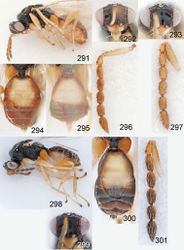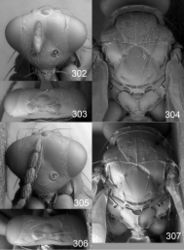Euplectrus hugokonsi
| Notice: | This page is derived from the original publication listed below, whose author(s) should always be credited. Further contributors may edit and improve the content of this page and, consequently, need to be credited as well (see page history). Any assessment of factual correctness requires a careful review of the original article as well as of subsequent contributions.
If you are uncertain whether your planned contribution is correct or not, we suggest that you use the associated discussion page instead of editing the page directly. This page should be cited as follows (rationale):
Citation formats to copy and paste
BibTeX: @article{Hansson2015ZooKeys, RIS/ Endnote: TY - JOUR Wikipedia/ Citizendium: <ref name="Hansson2015ZooKeys">{{Citation See also the citation download page at the journal. |
Ordo: Hymenoptera
Familia: Eulophidae
Genus: Euplectrus
Name
Euplectrus hugokonsi Hansson sp. n. – Wikispecies link – ZooBank link – Pensoft Profile
Material
Holotype a female labeled “COSTA RICA: Guanacaste, ACG, Sector Santa Rosa, Sendero Natural, 13.xi.1990, gusaneros, ex Dasylophia guarana eating Platymiscium parviflorum, no barcode, 90-SRNP-2035” (BMNH). PARATYPES: 2♀ 1♂ with same label data as holotype (BMNH, INBio).
Diagnosis
Lower face with median part white laterally and yellowish-brown medially, pale area reaching outside of level of outer lateral margins of toruli, with a black area the width of 1.5× the width of scape between pale area and eye margin (Figs 292, 293); vertex with parts lateral to ocellar triangle dark reddish-brown; fore and mid legs yellowish-white, hind leg yellowish-brown (Fig. 291); dorsellum along anterior margin with a wide groove, medially 0.5× as long as length of dorsellum (Fig. 759); petiole 0.8× as long as wide; gaster dark brown, anterior ½ with a large yellowish-white (female, Fig. 294) or white (male, Fig. 295).
Description
Female. Length of body 2.6–2.7 mm. Antenna with scape yellowish-white, pedicel yellowish-brown, flagellomeres 1–4 pale brown with ventral part yellowish-brown, 5–6 pale brown (Fig. 296). Mandibles and palpi white. Head black and shiny, vertex with parts lateral to ocellar triangle dark reddish-brown, lower face with median part white laterally and yellowish-brown medially, pale area reaching outside of outer lateral margins of toruli, with a black area the width of 1.5× the width of scape between pale area and eye margin (Fig. 292). Frons close to eyes with two rows of setae (Fig. 302). Vertex with very weak reticulation inside ocellar triangle, outside ocellar triangle smooth (Fig. 303). Occipital margin with a weak carina (Fig. 303).
Mesosoma black and shiny (Fig. 291). Each sidelobe of mesoscutum with nine setae. Scutellum 1.0× as long as wide; with engraved weak reticulation (Fig. 304). Dorsellum with a wide groove along anterior margin, medially 0.4× as long as length of dorsellum (Fig. 759). Propodeum with weak reticulation (Fig. 759); anteromedially with a semicircular cup; propodeal callus with six setae. Legs (Fig. 291): fore and mid legs yellowish-white, hind leg yellowish-brown. Fore wing: submarginal vein with four setae; costal cell with two irregular and sparse rows of setae on ventral surface, and margin with two setae close to marginal vein; with 22 admarginal setae, in one row.
Gaster dark brown, anterior ½ with a large yellowish-white ovate spot (Fig. 294).
Ratios. HE/MS/WM = 2.4/1.3/1.0; POL/OOL/POO = 6.3/3.3/1.0; OOL/DO = 1.3; WE/WF/WH/HH = 1.0/2.6/4.7/3.5; WH/WT = 1.0; PM/ST = 1.4; TS1/TS2/LT/LT1/LT2/LT3/LT4 = 4.4/2.6/6.8/2.5/1.6/1.0/2.0; LP/WP = 0.8; MM/LG = 1.1.
Male. Length of body 1.9 mm. Scape slightly expanded and widest medially (Fig. 297), sensory pores confined to anteroventral ¾, sensory area pale brown. Otherwise similar to female except gaster with anterior ½ white with dark brown lateral margins (margins narrower than in female) (Fig. 295), and shorter.
Ratios. LC/WS = 3.3; MM/LG = 1.3.
Hosts and biology
Feeding on intermediate instar larva of Dasylophia guarana (Notodontidae) feeding on Platymiscium parviflorum (Fabaceae), parasitoid cocoons stuck to dead larva and substrate.
Distribution
Costa Rica (Guanacaste Province).
Etymology
This species is named after Hugo Kons, in recognition of his contribution to the understanding of ACG Hymenoptera taxonomy.
Original Description
- Hansson, C; Smith, M; Janzen, D; Hallwachs, W; 2015: Integrative taxonomy of New World Euplectrus Westwood (Hymenoptera, Eulophidae), with focus on 55 new species from Area de Conservación Guanacaste, northwestern Costa Rica ZooKeys, (485): 1-236. doi
Images
|



